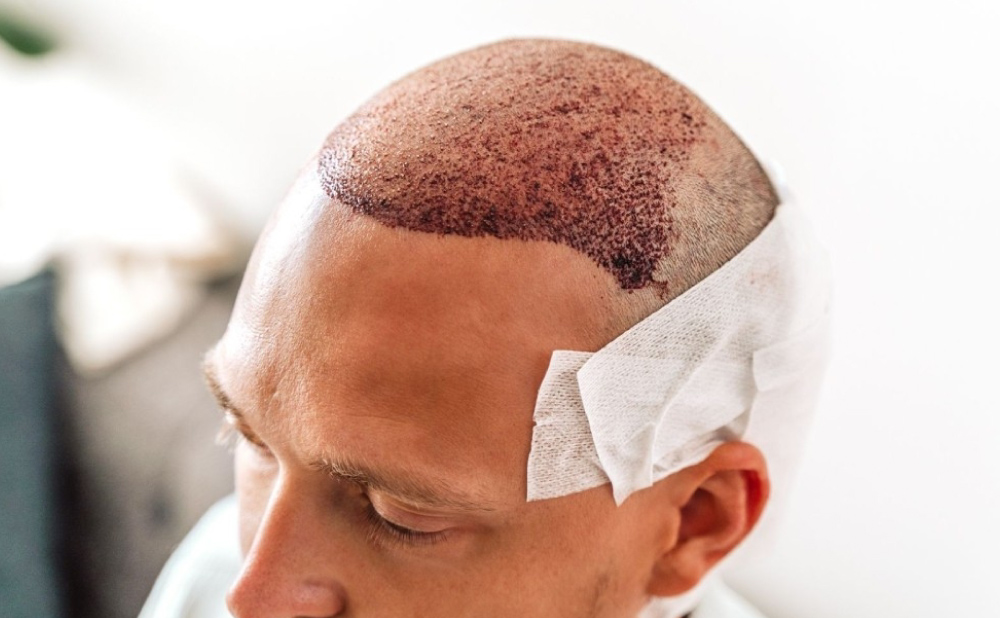
Healing is one of the most important phases after a hair transplant, and it often begins with the formation of scabs on the scalp. These small crusts develop as a natural response to the micro-incisions made during graft placement, acting as a protective layer while the skin repairs itself. Although scabbing is expected, many patients feel uncertain about how long it should last, whether it’s safe for scabs to fall off with hair, or what kind of care is needed during this stage.
In this article, you’ll learn about the hair transplant scab timeline, safe aftercare methods, and what to expect week by week during recovery.
What Are Hair Transplant Scabs?
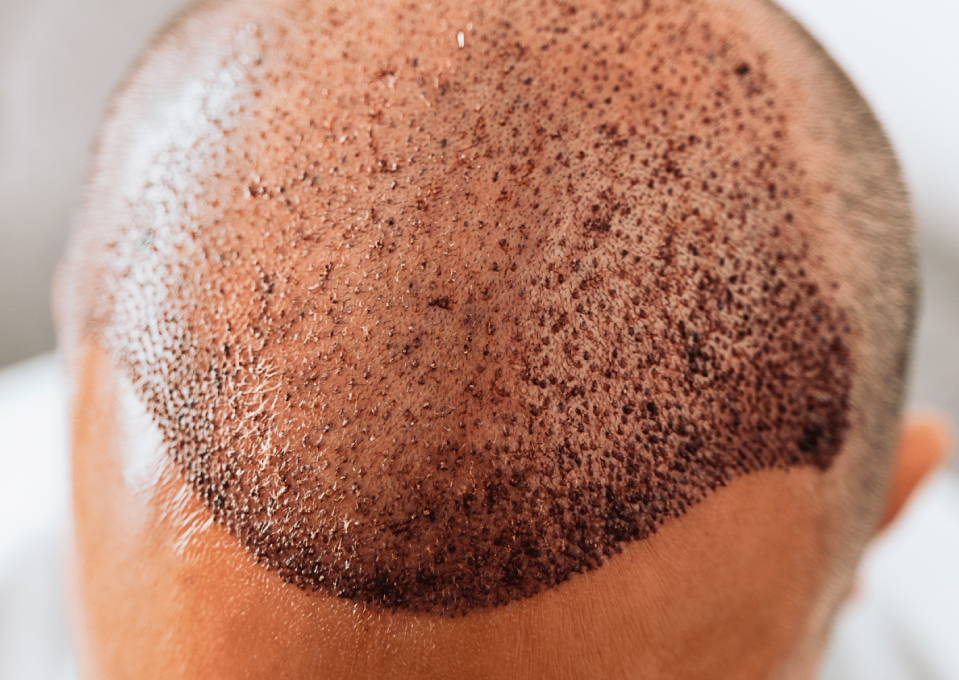
Hair transplant scabs are small crusts that form on the scalp after the procedure. During methods like FUE, DHI, or Sapphire hair transplant, micro-channels are created in the scalp to place individual hair grafts. In response, the body naturally produces fluid and blood at these sites, which then dry and create scabs over each graft.
These scabs, also called crusts, usually appear within the first two to three days. They are made up of dried plasma, blood, and tissue fluid. While they may look unusual or concerning, their presence is completely normal and signals that healing has begun.
As the days pass, scabs help protect the area and support early recovery. Patients often notice slight redness or itching during this stage. The scalp will gradually shed these scabs over the next 10 to 14 days, revealing the skin underneath and the initial signs of hair growth. Avoiding irritation and following proper washing instructions are important to protect the grafts and support a healthy result.
Why the Hair Transplant Scab Stage Matters
The presence of scabs after a hair transplant is a normal and healthy part of recovery. Here’s why this stage is important:
- Indicates healing: Scabs form as a protective response to the micro-incisions, signaling that the scalp is healing properly.
- Helps grafts settle: The scabs cover and protect each graft, allowing the follicles to stabilize in place during the early days.
- Shows recovery is on track: When scabs follow the typical timeline of forming and falling off, it’s a good sign that your recovery is progressing as expected.,
Important: Improper care, such as scratching or picking at scabs, can dislodge the grafts, lead to scarring, and compromise the final results. Following the recommended aftercare routine during this phase is essential for long-term success.
Post Hair Transplant Scab Care
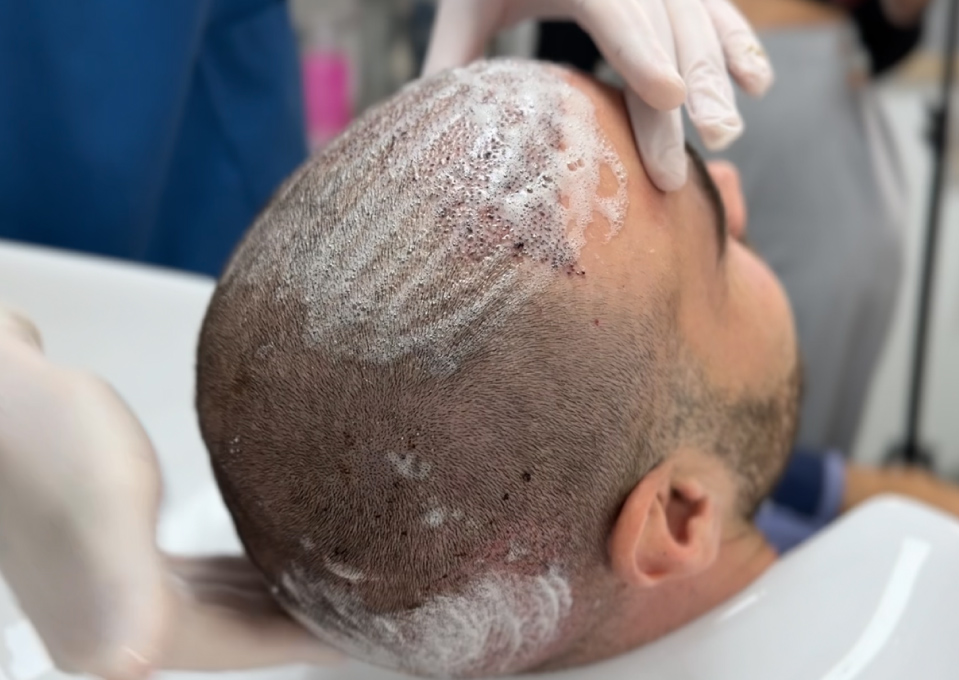
The period following a hair transplant is a delicate and important phase. How the scalp is treated during the first two weeks has a direct impact on healing quality and the survival of the grafts.
The primary objectives during this stage are:
- Maintain the integrity of the transplanted grafts
- Support the natural shedding of scabs
- Prevent any risk of irritation or infection
Typical daily post hair transplant scab care activities are:
- Washing: Begins gently between day 3 and 5 using a mild, pH-balanced shampoo
- Moisturizing: Usually with a clinic-recommended spray or lotion to soften scabs
- Sleeping position: Head kept elevated to reduce swelling and avoid pressure
- Monitoring: Keep an eye on the scalp for signs of unusual redness or sensitivity
The following comparison highlights care methods that support recovery, alongside habits that may interfere with it.
Best Practices vs. Common Mistakes
| Best Practices | Common Mistakes to Avoid |
|---|---|
| Adhere closely to the clinic’s recommended washing schedule | Picking or scratching at scabs, even lightly |
| Use only approved shampoos, sprays, or aftercare products | Applying unapproved substances such as oils or creams |
| Cleanse the scalp gently, without pressure | Rubbing, massaging, or over-washing the area |
| Keep the head slightly elevated while sleeping | Lying flat or sleeping in positions that apply pressure to the scalp |
| Contact the clinic if anything unusual appears | Ignoring prolonged redness, swelling, or scabs that remain beyond expected timelines |
Hair Transplant Scab Healing Process: What to Expect
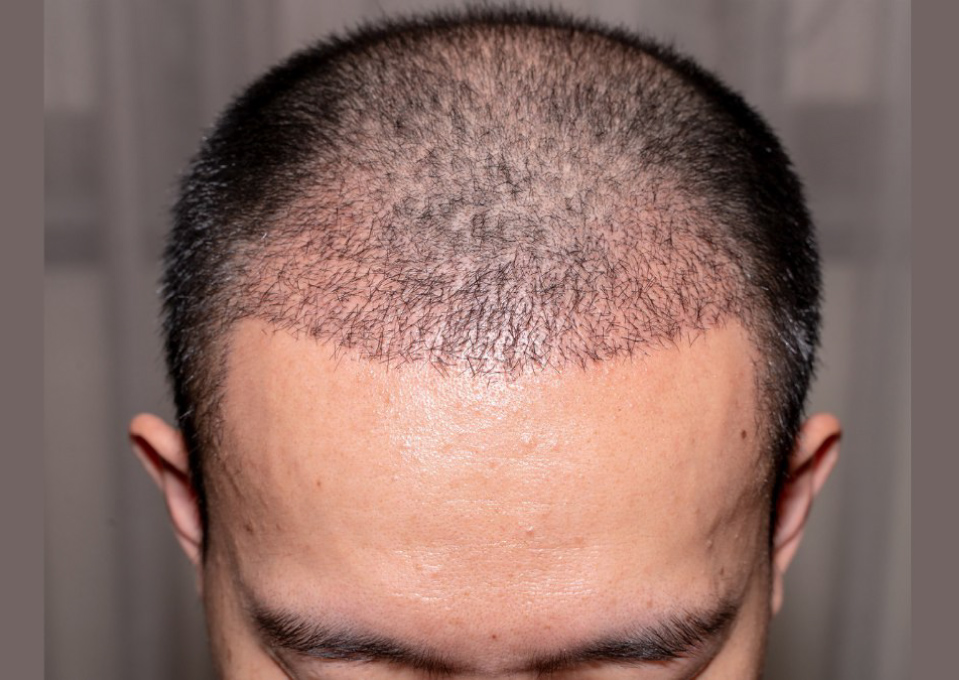
Following a hair transplant, scabs typically begin to form within the first 24 to 72 hours as the scalp responds to the micro-incisions created during graft placement. Plasma and blood clot around each graft, forming protective crusts that gradually harden into visible scabs.
By the end of the first week, scabs usually cover most of the recipient area. Mild redness and itching are common during this phase. Starting from day 3 to 5, gentle washing helps to soften the crusts, and over the next several days, they begin to loosen.
Between days 10 and 14, the majority of scabs fall off naturally. At this point, the underlying skin may appear slightly pink or sensitive, which is a normal sign of tissue recovery. The scalp continues to settle in the following weeks, and by the third week, most patients no longer see visible scabs, allowing the focus to shift toward early hair growth.
Hair Transplant Scabs Timeline: Week-by-Week Healing Process
Understanding how scabs progress after a hair transplant helps set realistic expectations and prevents unnecessary worry. While healing can vary slightly from person to person, the general timeline follows a predictable pattern. Here’s what typically happens from day one through the third week.
To better understand how scabbing fits into the full recovery process, including when growth begins and how the scalp evolves, see our Hair Transplant Timeline: A Guide to Hair Transplant Recovery & Growth Chart.
Hair Transplant Scabs After 1 Day
In the first 24 hours, the scalp may appear slightly red and swollen. The grafts are fresh, and while there may be some tenderness, scabs have not yet developed. It is important to avoid touching or disturbing the area to give the scalp a chance to stabilize.
Hair Transplant Scabs After 3 Days
By day 3, early crusts start forming around each graft as part of the natural healing process. These light scabs are often accompanied by mild itching, which is a normal response. During this phase:
- The scalp should remain dry
- Washing is not yet recommended unless specifically instructed
- Scratching should be avoided, even gently
Hair Transplant Scabs After 7 Days
At this stage, scabs become more defined and hardened. This is when patients are generally advised to begin gentle washing using clinic-approved shampoo and techniques. The goal is to soften the scabs gradually without applying force or trying to remove them manually.
Hair Transplant Scabs After 10–14 Days
Scabs typically begin to flake off naturally as the skin continues to heal. The scalp may look uneven or slightly pink in areas where scabs have detached. Washing remains important but should still be done gently, avoiding any rubbing or pressure. If scabs are still firmly attached beyond day 14, it may be time to check in with the clinic for further guidance.
Hair Transplant Scabs After 3 Weeks
By the third week, most scabs should be gone. The scalp is usually clear, with only occasional dry flakes in some cases. If scabs persist or the area shows signs of redness, discomfort, or inflammation, this could point to delayed healing or an issue that requires medical attention.
Hair Transplant Scabs Removal: When and How to Help Them Fall Off Safely
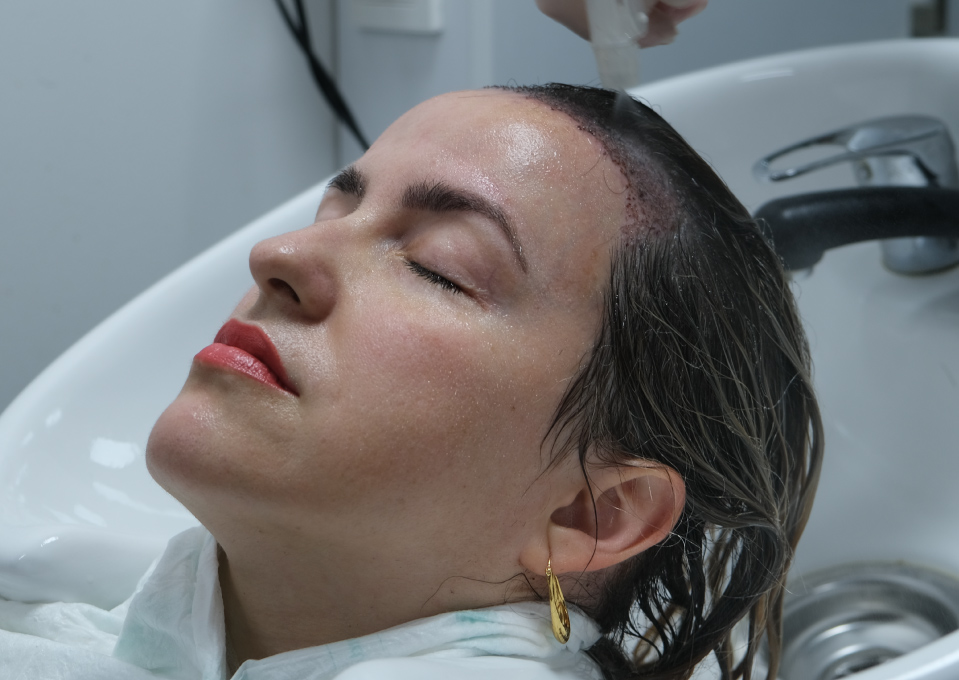
Scabs should never be picked or removed manually, as doing so can dislodge grafts, cause bleeding, and compromise the success of the transplant. However, there are safe ways to support the natural shedding process once the grafts have become stable, usually around day 10.
To assist the removal of scabs safely:
- Use the recommended shampoo and lukewarm water during washing, applying it gently with the fingertips or a soft sponge.
- After rinsing, pat the area dry with a clean towel. Avoid rubbing or pressing.
- From around day 10, if advised by your clinic, begin light circular massages during washing. This helps soften the scabs and encourages natural flaking.
- Continue using any aftercare spray or lotion provided to keep the scalp hydrated and prevent dryness that may slow the shedding process.
If scabs remain beyond 21 days, or if they appear inflamed, thickened, or unusually attached, this could indicate delayed healing or improper aftercare. In such cases, it is strongly recommended to contact your medical provider for evaluation and guidance.
Frequently Asked Questions About Hair Transplant Scabs
What if hair transplant scabs are not falling off?
If scabs have not started to fall off by day 14, or if they are still fully intact after 21 days, it may suggest delayed healing or overly dry skin. Avoid removing them by force. Instead, continue with gentle washing and moisturizing products as advised. If the scabs remain unchanged, it is best to contact the clinic for professional guidance.
Are hair transplant scabs supposed to fall off with hair?
Yes, it’s common for some hairs to shed along with the scabs. This is part of the normal post-transplant process called “shock loss,” where the transplanted hairs fall out before regrowing. It does not mean the grafts have failed, as the follicles remain beneath the skin and will produce new hair in the coming months.
For a closer look at this stage, including why it happens and what to expect, read Hair Transplant Shedding Phase: Does Transplanted Hair Fall Out?
How can I get rid of scabs after a hair transplant?
The safest way to help scabs fall off is by:
- Washing with lukewarm water and mild shampoo
- Gently massaging the scalp (starting around day 10, if instructed)
- Staying consistent with any prescribed aftercare sprays
Avoid picking, rubbing, or using products not approved by your clinic.
Is there a correct method for scab removal after a hair transplant?
Yes. Scabs should be allowed to loosen and detach on their own. Manual removal is not advised. Start washing as instructed by the clinic, usually between day 3 and 5. From day 10 onward, light circular movements during washing can help speed up natural shedding if approved by your medical team.
Can scratching scabs damage the grafts?
Yes. Scratching can dislodge newly implanted grafts, especially within the first 7 to 10 days. Even light scratching may cause trauma to the area and result in poor graft survival or scarring. If itching is intense, speak to the clinic about using a moisturizing spray or soothing solution.
Is it normal for scabs to itch?
Mild itching is very common during healing, especially as the scabs begin to dry and lift. It’s typically a sign that the skin is repairing itself. Resist the urge to touch or scratch, and use clinic-recommended moisturizers to reduce discomfort.
Why do scabs form unevenly across the scalp?
Scabbing may appear thicker or more clustered in certain areas depending on the number of grafts placed, skin sensitivity, and how the blood vessels respond in different regions. As long as there are no signs of infection or excessive swelling, this variation is generally harmless.
Do all patients experience scabbing after a transplant?
Most patients will develop scabs, though the extent can vary. Factors such as skin type, bleeding tendency, and how the procedure was performed may influence the amount of crusting. Patients with less visible scabbing still need to follow the same aftercare routine.
When will my scalp return to a normal appearance?
Most scabs fall off by day 14, and the scalp begins to look clearer by week three. Some redness or pinkness may remain for a few more weeks, especially in lighter skin tones. This fades gradually as the skin recovers.
Can I speed up the scab healing process?
The best way to support healing is by strictly following post-operative care instructions. While you can’t rush the process, staying hydrated, avoiding sun exposure, and gently washing the scalp as directed can help promote healthy recovery.
Heal Safely with Expert Care After Your Hair Transplantation in Turkey at MCAN Health
Scabs are a normal part of healing after a hair transplant, but the way they are managed can have a lasting impact on the final outcome. With proper care, guided washing routines, and expert monitoring, patients can protect their grafts and move through each stage of healing with confidence.
MCAN Health provides complete medical care that extends far beyond the surgery itself. From detailed post-operative instructions to daily nurse visits and 24/7 multilingual support, every patient receives the attention needed to heal safely and effectively. The team closely monitors scab formation, shedding, and scalp health to help avoid complications and achieve the most natural-looking results.
Recognized for international standards, with over 15,000 satisfied patients and a 4.8-star rating, MCAN Health is trusted by people from across the world seeking high-quality hair transplant in Turkey. To experience a safe, smooth recovery supported by professionals at every step, book a free consultation and receive your personalized treatment plan.
 Male Rhinoplasty: Preserving and Enhancing the Masculinity
Male Rhinoplasty: Preserving and Enhancing the Masculinity  In Which Stages of Gyno Are You?
In Which Stages of Gyno Are You?  Do You Need a Breast Lift, Breast Reduction or Both?
Do You Need a Breast Lift, Breast Reduction or Both?